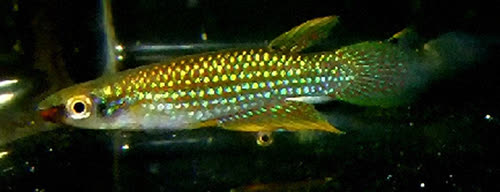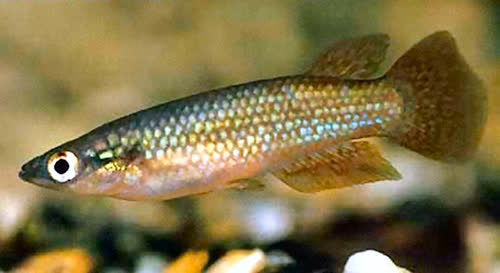|
|||||
|
arnoulti |
|
nuchimaculatus No photos exist.
From Paul Loiselle's review of Pachypanchx: Guichenot (1866) described Poecilia nuchimaculata from a single specimen collected
by J. P. Goudot, a French resident of Madagascar from 1835 until his death in the early
1860's. The specimen lacks precise locality data and as Goudot’s journals were lost when
he disappeared while in the field (Dorr, 1997), subsequent efforts to determine its
provenance have proved fruitless. Published data (Huber, 1998) indicate that with regard
to both morphometric and meristic characters the type falls within the range that defines
the Malagasy representatives of the genus Pachypanchax. He noted that the prefrontal
scales of this specimen are smaller than those of other Pachypanchax species, while the
lateralis system consists of open rather than enclosed pores. The caudal squamation is
rather light, with scales present only on the basal third of the fin (de Soutter, pers. com.), a
feature shared with only one other Malagasy congener. Radiographic examination of the
caudal skeleton confirms Huber’s observation that a shallow notch separates the upper
plate, formed by the fusion of third, fourth and fifth hypural bones and the lower plate,
formed by the fusion of the first and second bones. This condition is more reminiscent of ZOOTAXA
that found in many representatives of the Nothobranchidae (upper and lower plates
separated by a deep groove), than that seen in Aplocheilus (hypural skeleton made up of
three independent elements, the upper- and lowermost comprising the fused fourth and
fifth and first and second hypural bones respectively).
|
|
omalonotus OMO has been around a very long time but Loiselle when he went back to collect from the original collection point he found a different fish actually a new species he named ARN. OMO and ARN don't live anywhere near each other. |
|
playfairii |
|
patriciae |
|
sakaramyi |
|
sparksorum |
|
varatraza |









 the Indian Ocean. Bedotia are found here. The west cost is dry and sandy. Pachypanchax live here except for the one location where one species lives on the other coast.
the Indian Ocean. Bedotia are found here. The west cost is dry and sandy. Pachypanchax live here except for the one location where one species lives on the other coast.












